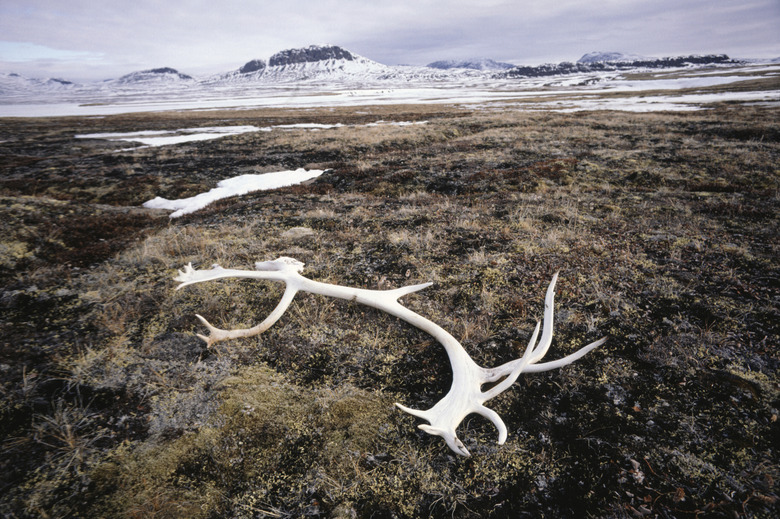What Is The Wind In A Tundra?
Whether it's the Arctic tundra of the Northern Hemisphere's high latitudes or the alpine tundra of mountain benches and lofty plateaus, tundra environments tend to be windy places. From howling gales pounding a high, barren slope to a coastal ground blizzard, tundra winds exacerbate the natural frigidity of these severe, remote ecosystems. They can also exert profound effects upon the landscape's look and ecological dynamics.
Tundra Winds
Tundra Winds
Because of the lack of gust-buffering forests, both Arctic and alpine tundra are commonly windswept landscapes. Air chilled by traveling over mostly snowbound highlands and mountain masses in the subarctic and polar latitudes is tugged by gravity down into adjoining tundra lowlands in the form of katabatic winds. These can be quite powerful, as can prevailing winds over coastal tundra on Alaska's North Slope. Alpine tundra may be regularly battered by hurricane-force winds funneled by the rough, storm-generating topography of high mountains.
Wind and Landscapes
Wind and Landscapes
Fiercely cold and arid prevailing winds help keep tundra plants short and ground-hugging, thus helping to shape the look of the landscape. Winter snow actually buffers such plants from the freezing and desiccating winds. This is often an even starker phenomenon in the high country at timberline, on the fringe of alpine tundra: The twisted shapes of pines and firs are molded by the level of sheltering snow and the direction of prevailing winds. Such gales are a predominant factor in sculpting the timberlines on many mountains. Prevailing winds along an Arctic tundra seacoast may help shape the surrounding pack-ice, as well as ice-wedge permafrost lakes inland.
Wind and Caribou
Wind and Caribou
In Eurasia and North America, the quintessential tundra grazer is the caribou, or reindeer. The barren-ground caribou of northern Canada and Alaska conducts some of the world's longest terrestrial migrations between wintering grounds — typically in boreal forest — and calving territory on open tundra. The immense hordes of biting insects characteristic of the tundra summer impact caribou movement and behavior: The ungulates tend to seek refuge along seacoasts and exposed mountain ridges where stiff winds provide at least some relief from mosquitoes, warble flies and other scourges. Hardy caribou that stick out winters in tundra landscapes seek wind-scoured areas where lichen, a critical cold-season sustenance for the animals, is exposed.
Storm Surges
Storm Surges
Winds can cause occasional ecological disturbances on tundra, just as they do in other ecosystems. In September 1970, for example, a marine storm brought westerly winds gusting to 130 kilometers per hour (70 miles per hour) and beyond along the Beaufort Sea coastline of northern Alaska and northwestern Canada, creating a significant storm surge over oceanfront tundra. The coastal plain was flooded, bluffs eroded, freshwater deltas invaded by saltwater, and driftwood and sea ice hurled inland by heavy waves. Research suggests that such weather systems, which reverse the coastline's predominant easterly wind and wave flow, may wreak similarly violent surges in the area every century or so.
References
- Physical Geography: A Landscape Appreciation; Tom L. McKnight
- Timberline: Mountain and Arctic Forest Frontiers; Stephen F. Arno, Ramona P. Hammerly
- Encyclopedia Britannica: Katabatic Wind
- University of California Museum of Paleontology: The Tundra Biome
- National Aeronautics and Space Administration: Earth Observatory Image of the Day — Extensive Ice Fractures in the Beaufort Sea
- U.S. Fish and Wildlife Service: Arctic National Wildlife Refuge — Ice Wedges, Polygons, and Pingos
- Alaska Department of Fish and Game: Caribou Species Profile
- U.S. Fish and Wildlife Service: Arctic National Wildlife Refuge — Caribou
- Arctic; Effects of Storm Surges on the Beaufort Sea Coast, Northern Alaska; Erk Reimnitz, Douglas K. Maurer
Cite This Article
MLA
Shaw, Ethan. "What Is The Wind In A Tundra?" sciencing.com, https://www.sciencing.com/wind-tundra-23826/. 24 April 2017.
APA
Shaw, Ethan. (2017, April 24). What Is The Wind In A Tundra?. sciencing.com. Retrieved from https://www.sciencing.com/wind-tundra-23826/
Chicago
Shaw, Ethan. What Is The Wind In A Tundra? last modified March 24, 2022. https://www.sciencing.com/wind-tundra-23826/
